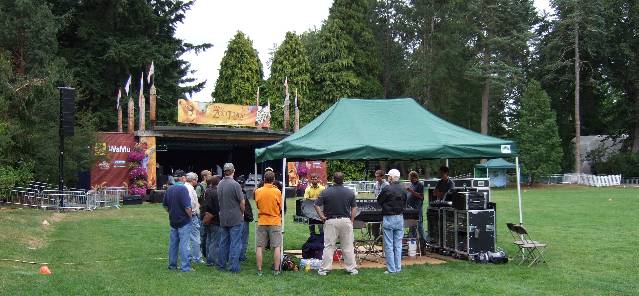

In an unusual summer gathering, the PNW Section presented a meeting on August 8, 2007 demonstrating a typical medium format temporary outdoor music reinforcement system with some atypical requirements because of the venue - Seattle's Woodland Park Zoo. About 15 people (6 were AES members) were able to make the mid-week noontime presentation, scheduled between the main setup and talent load-in. Attendees could also attend the evening concert for free.
The Woodland Park Zoo in Seattle holds a family oriented summer concert series on its Meadow, a large grassy area with a small stage, where up to 8,000 people bring their own (short) chairs or blankets. Dansound Inc. has been the sound contractor for the series since its inception 24-years ago. The series has presented acts here such as Los Lobos, Judy Collins, Indigo Girls, Doc Watson, Etta James and Little Feat. Today's concert was for country music singer-songwriter Robert Earl Keen. Dan Mortensen of Dansound described the venue situation and led a tour of the setup, starting with the FOH (front of house) mixing and processing station in the seating area, to the stage and monitor mixing equipment, to the main speakers, and ending with sound demonstrations and listening tests.
Dan described the unusual venue requirements while the group gathered at the FOH location. The concert series started originally as an acoustic singer/songwriter style series and eventually included rock style bands. However, the acts are warned about shock noise content. Anything that resembles a gunshot is particularly bad. The outdoor venue is in an urban zoo, about 50 feet from an emu/walleroo exhibit and perhaps 100 feet from the snow leopards, with residential homes and apartments within a thousand feet in several directions. The zoo doesn't want sound levels or content that will disturb the animals, the city has laws limiting SPL (sound pressure level), and you still need to cover a 2.4 acre lawn with pleasing sound for people. It's a balancing act.
Local ordinance requires no more tha 95dBA SPL 50 feet from the speaker averaged over one minute and 57dBA SPL crossing the property line. The ordinary Radio Shack-type sound level meter with time average function is considered acceptable, although intermittant street traffic noises can easily skew a property line reading. Specifying an A-weighted number is actually helpful in that low frequencies are filtered on the meter and one can have a bit of bass while keeping the reading within the law. What would not be so helpful is occasional talk about adding hazy and hard to quantify audibility clauses to local ordinances. Audibility will vary greatly by the presence or absence of background noise, so locations next to a busy street would be able to get away with more absolute volume, while areas with no background noise would have to conform to a very strict standard.
The group then proceeded to the stage for a look at the power distribution, signal flow for the stage connections and monitoring setup. The stage, while permanent, is somewhat small and acoustically not particularly well designed, requiring some accomodations. We continued to the subwoofers in front of the stage, then the main speakers on Genie lifts, which were self-powered Meyer Sound Labs M'elodie line arrays. Attention to weatherproofing was pointed out in all the systems. Back at the FOH position, the mixing and processing were described, and more discussion of the line array technology.
Finally, attendees roamed the meadow for some listening tests of recorded music.
Reported by Gary Louie, AES PNW Secretary
Last modified 8/12/2007.